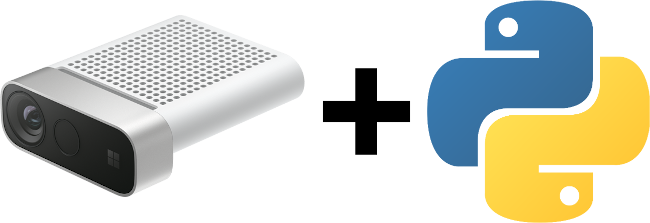Python wrapper over Azure Kinect SDK
Project description
pyk4a
This library is a simple and pythonic wrapper in Python 3 for the Azure-Kinect-Sensor-SDK.
Images are returned as numpy arrays and behave like python objects.
This approach incurs almost no overhead in terms of CPU, memory or other resources. It also simplifies usage. Kinect C api image buffers are directly reused and image releases are performed automatically by the python garbage collector.
Homepage: https://github.com/etiennedub/pyk4a/
Prerequisites
The Azure-Kinect-Sensor-SDK is required to build this library. To use the SDK, refer to the installation instructions here.
Install
Linux
Linux specific installation instructions here
Install both packages libk4a<major>.<minor> and libk4a<major>.<minor>-dev. The latter contains the headers and CMake files to build pyk4a.
Make sure your LD_LIBRARY_PATH contains the directory of k4a.lib
pip install pyk4a
Windows
In most cases pip install pyk4a is enough to install this package.
When using an anaconda environment, you need to set the environment variable CONDA_DLL_SEARCH_MODIFICATION_ENABLE=1 https://github.com/conda/conda/issues/10897
Because of the numerous issues received from Windows users, the installer (setup.py) automatically detects the kinect SDK path.
When the installer is not able to find the path, the following snippet can help. Make sure you replace the paths in these instructions with your own kinect SDK path. It is important to replace 1.4.1 with your installed version of the SDK.
pip install pyk4a --no-use-pep517 --global-option=build_ext --global-option="-IC:\Program Files\Azure Kinect SDK v1.4.1\sdk\include" --global-option="-LC:\Program Files\Azure Kinect SDK v1.4.1\sdk\windows-desktop\amd64\release\lib"
During execution, k4a.dll is required. The automatic detection should be able to find this file.
It is also possible to specify the DLL's directory with the environment variable K4A_DLL_DIR.
If K4A_DLL_DIR is used, the automatic DLL search is not performed.
Example
For a basic example displaying the first frame, you can run this code:
from pyk4a import PyK4A
# Load camera with the default config
k4a = PyK4A()
k4a.start()
# Get the next capture (blocking function)
capture = k4a.get_capture()
img_color = capture.color
# Display with pyplot
from matplotlib import pyplot as plt
plt.imshow(img_color[:, :, 2::-1]) # BGRA to RGB
plt.show()
Otherwise, a more avanced example is available in the example folder. To execute it opencv-python is required.
git clone https://github.com/etiennedub/pyk4a.git
cd pyk4a/example
python viewer.py
Documentation
No documentation is available but all functinos are properly type hinted. The code of the main class is a good place to startPyK4A.
You can also follow the various example folder scripts as reference.
Bug Reports
Submit an issue and please include as much details as possible.
Make sure to use the search function on closed issues, especially if your problem is related to installing on windows.
Module Development
-
Install required packages:
make setup -
Install local pyk4a version (compiles pyk4a.cpp):
make build
Contribution
Feel free to send pull requests. The develop branch should be used.
Please rebuild, format, check code quality and run tests before submitting a pull request:
make build
make fmt lint
make test
Note: you need clang-format tool(v 11.0+) for formatting CPP code.
Project details
Release history Release notifications | RSS feed
Download files
Download the file for your platform. If you're not sure which to choose, learn more about installing packages.
Source Distribution
File details
Details for the file pyk4a-1.5.0.tar.gz.
File metadata
- Download URL: pyk4a-1.5.0.tar.gz
- Upload date:
- Size: 24.4 kB
- Tags: Source
- Uploaded using Trusted Publishing? No
- Uploaded via: twine/4.0.2 CPython/3.10.4
File hashes
| Algorithm | Hash digest | |
|---|---|---|
| SHA256 |
57e1c69a39e936e1610771401ad68f0c9b3788d14c2f4998678854904d3c2d1b
|
|
| MD5 |
f76a2fba9e20dac02c9dd427008ee8bb
|
|
| BLAKE2b-256 |
5af992c3f43caf0a8ad5ca1414be0096b8e046604a90cabe84f12173794ac130
|














